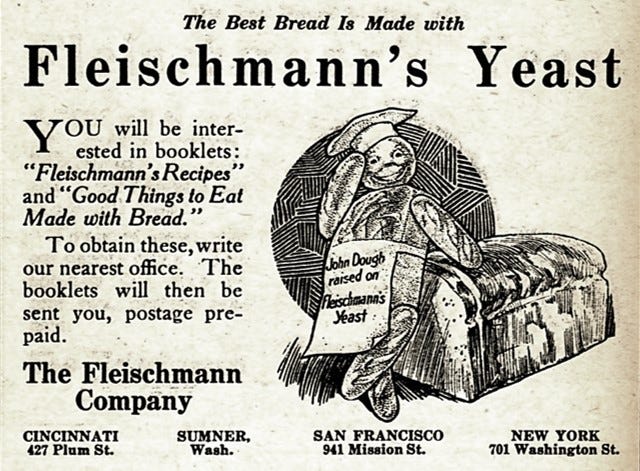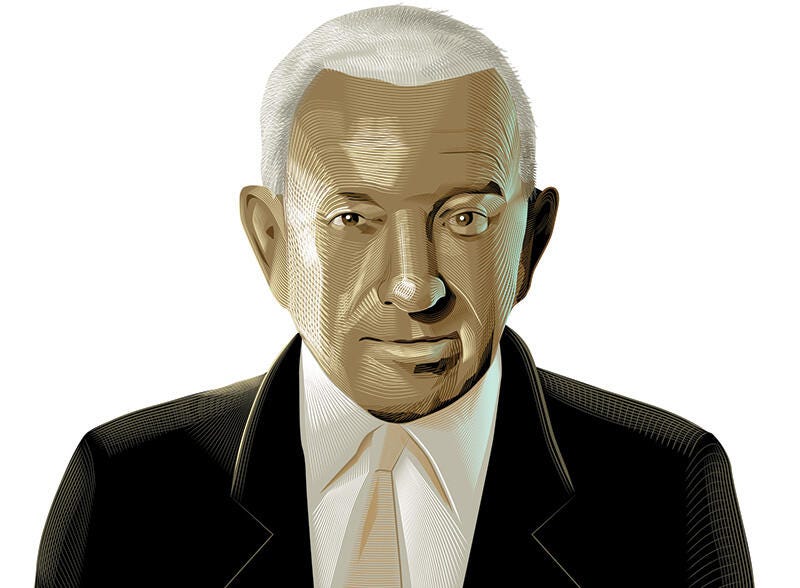How Fleischmann's Yeast created both CBS and The New Yorker magazine
An odd media history story about big media and yeast, from the 1920s.
Today’s Lint Trap is about an odd fact that got stuck in my memory as I researched media history, but I’ve never seen fully developed in the scholarship (as far as I know?).
Fleischmann’s Yeast, or, more specifically, Raoul Fleischmann and Betty Fleischmann Holmes, two inheritors of the Fleischmann’s Yeast fortune, can be credited with providing the critical foundational investments that guaranteed the survival (and eventual flourishing) of The New Yorker magazine and the CBS broadcasting network.

Their critical media investments have nothing to do with sponsorship or commercials. Or bread baking. How two inheritors of the Fleischmann Yeast fortune made possible two of the most important media entities in American history is really a story about how wealthy people are often required to subsidize flailing and unprofitable independent media companies until they hit it big and emerge as dominant media behemoths.
First story: Raoul Fleischmann and the New Yorker. Fleischmann was born while his parents were visiting their native Austria (on a trip from the United States) on August 17, 1885, and raised in great wealth due to his uncles’ successful baking business. He attended Princeton for one year, but (according to Princeton Alumni Weekly) “at the time, setting foot in a classroom was enough to ensure alumni status, and he appeared in alumni directories for life.” (He actually graduated from Williams College). After graduating from Williams, he moved to New York City and started in the baking business. But he didn’t enjoy the family industry. In 1924, he was approached by his friend Harold Ross, and solicited to invest in a magazine that was in formation. When the New Yorker debuted in early 1925, it was a hit with the critics and the elite. But its lack of advertising and subscriptions made it a costly and unprofitable venture. Just three months in, Fleischmann was ready to give up:
Publishing is a money pit, and in May 1925, Fleischmann, frustrated that the magazine, then three months old, was pulling $5,000 a week out of his wallet without turning a profit, resolved to end his support. He booked a table at the Princeton Club with Ross and two other employees, John Hanrahan and Hawley Truax, to tell them the bad news. “Leaving the club, the four of us started walking up Madison Avenue,” he later said. “It was at 42nd Street, during a traffic lull, that I heard Hanrahan say to Truax or Ross, behind me, ‘I can’t blame Raoul for a moment for refusing to go on, but it’s like killing something that’s alive.’”
The comment “got under my skin,” Fleischmann said. He stayed, and the magazine thrived.

The estimates of how much money Fleischmann (and his mother) sunk into the New Yorker in its first few years varied, but the New York Public Library has it at $700,000 between 1925 and 1927 (the magazine became profitable in 1928 and never lost money again). By the time he died, he owned 20% of the outstanding stock in the magazine, which earned him millions annually. He remained involved with the magazine for his entire life, serving at different times as vice president, president, chairman and publisher.
***
Second story: Bettie Fleischmann Holmes and CBS. The best versions of this story were told in Gleason Archer’s 1939 book, Big Business and Radio, and retold in summary fashion in Erik Barnow’s A Tower in Babel (1966).

Mrs “Bettie” Babette (Fleischmann) Holmes, of Cincinnati (and later, New York), was born in 1873. She was the daughter of one of Raoul Fleischmann’s uncles - Charles Louis Fleischmann - who started the Fleischmann Yeast Company. She loved music, and was a patron of the Cincinnati Symphony Orchestra before she moved to New York City and became a director of the New York Philharmonic Symphony Society and a board member of the Metropolitan Opera Guild. It was through her connections to music that she became involved in CBS.
CBS originally began as the “Judson Radio Program Corporation,” (incorporated on September 20, 1926) when talent agent Arthur Judson and a Wall Street stock promoter named George A. Coats put together a company to compete with NBC. Judson’s attempt to manage the newly created NBC’s talent had been brusquely rejected by David Sarnoff, and, in revenge, Judson and Coats decided to go into the radio network business. Neither had any idea how the radio network business actually worked, but Judson knew Bettie F. Holmes from his connections at the New York Philharmonic, and she put up a critical $5,000 investment to get the company launched. Soon, the Judson Radio Program Corporation evolved into a company called United Independent Broadcasters (UIB), which had almost no capital and barely survived as a radio chain. The entire company “fitted comfortably into a couple of office rooms in the Paramount Building in Times Square,” recalled Ted Husing. “On paper, our scheme sounded fair enough, but in practice C.B.S. began dropping into the red at once…We looked like a sure flop.” (Husing, Ten Years Before the Mike (1935), p.93). Before the Paley and Levy families purchased it in 1929 (and turned it into the CBS we know today), the UIB struggled for almost two years, always near insolvency.
At one critical point, UIB was rescued by the Columbia Phonograph Company, which insisted that in exchange for a sponsorship contract, the chain be renamed the Columbia Phonograph Broadcasting System (CPBS). But only months later, when Columbia Phonograph walked away from the deal, the network was about to collapse. That’s when Judson sent a desperate telegram to Holmes. Holmes agreed to rescue the chain, and forwarded Judson and Coats an additional immediate investment of $6,000. She eventually invested a total of $29,500 into the flailing network (making her the chain’s biggest backer at one point). Eventually, the network made its way into the hands of William S. Paley, who in 1929 subsumed the outstanding UIB stock into a new CBS offering. Erik Barnouw reported (in A Tower in Babel) that when Holmes eventually sold her UIB-CBS stock it was worth $3 million.
There exist numerous biographies of Holmes available on the web, but almost all omit the fact that she was the reason CBS survived (and eventually prospered). However, in prepping this post, I discovered that Holmes and her husband, Dr. Christian Holmes, were the great-grandparents of Elizabeth Holmes, the convicted swindler behind the Theranos scam.
***
Now, the curious thing is that in the mid-1920s, when The New Yorker and CBS were being launched, was not a huge moment for yeast and bread baking. Fleischmann’s Yeast, however, was doing spectacularly well. That’s because it got into the advertising game as a… laxative. And the company used the most modern forms and formats available to sell yeast as a digestive aid. For example, in Rudy Vallée’s Fleischmann Hour radio program, in the interim between songs, Vallée would casually stroll around the nightclub and the listener would get to eavesdrop on the patrons at the tables. Inserted into the snippets of “overheard” conversations would be young couples conversing, where either the male or female would extol the virtues of Fleischmann’s Yeast for keeping healthy, hearty and happy. It was product placement before the term existed. Cynthia Meyers, in A Word From Our Sponsor, researched in the J. Walter Thompson Agency archives at Duke University, and found the admen that came up with the Fleischmann’s Yeast campaign to sell it as a cure-all for “headaches, fatigue, acne, and constipation.” Those radio ads made sales skyrocket (also see Roland Marchand’s Advertising the American Dream: Making Way for Modernity, 1920-1940 (1985) for more on the bizarre Fleischmann’s Yeast craze of the 1920s).
So if you like and respect The New Yorker and the Columbia Broadcasting System, and all that they contributed to informing the American public sphere in the 20th century, you should place credit where due: to a yeast company that tricked millions of Americans into consuming its baking product as a miracle patent medicine.
**Note: Before I began this (too long) post, I was unaware of the connection between Bettie Fleischmann Holmes and Elizabeth Holmes. I find it fascinating that the great-granddaughter of a CBS founder ended up in jail for swindling people by exploiting the media. This place really is a lint trap of history.

